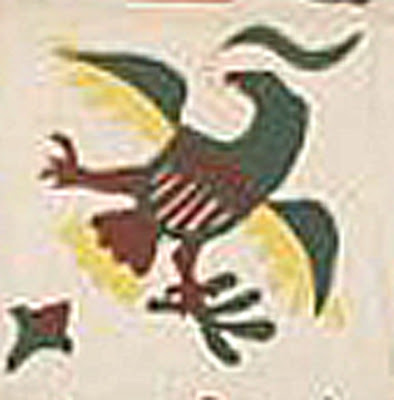Eagle from a sampler quilt dated 1851
Pook & Pook auction
Fans of patriotic quilts are quite familiar with this eagle design, which appears in quilts from about 1840 through the early twentieth century.

Spread eagle, sometimes with two stars, often with a banner.
Usually holds olive branches and arrows in the claws
(although this one is missing the olive branches.)
You start with a circle and make 8 slashes and turn under the edges
1940 watercolor of an old sampler
1856 sampler, collection of Barb Vedder
All peace and love, from a sampler at a Skinner auction
The pattern was particularly popular about 1880-1920
in Ohio sampler/albums. This Ohio quiltmaker (not
good with points) created a four pointed star.
I've considered the meaning of the design over the years especially in the context of antebellum America and the other day came across this image that is very interesting:
Spread eagle with arrows and olive branches and two six pointed stars.
It's a brass button with a shank back, one of two created for the
Cold Water Army, a cultural phenomenon of the 1840s.
Buttons possibly by the Scovill Company of Waterbury,
Connecticut, which created many brass buttons for
military uniforms---for militias of the 1840s to
Civil War regiments.
This button from a New Hampshire militia shows their logo,
an important image to martial men.
And to boys who wanted to be martial men.
The Cold Water Army with its eagle buttons appealed not
to adult volunteers in local military companies but to children....
Cold Water Army of boys in uniform---did those short
jackets sport brass buttons?
who were encouraged to swear against alcohol at a young age
and show their temperance affiliations in ceremonies and parades.
Girls reading the Cold Water Army periodical
Did girls collect buttons too?
Maybe for charm strings.
The Cold Water Army was definitely marketed (as we'd say) to children.
Collecting white ribbons, brass buttons and tokens would be fun and
appealed to their need to belong.
Mottoes were many:
"That's the Drink for Me"
referring to cold water.
Token, punched so it could be worn on a string
"So here we pledge perpetual hate
To all that can intoxicate."
Historic New England collection
One signed a pledge, which could be framed.
The Cold Water Army was part polemic and part how-to book. Here's how to offer an alternate Independence Day celebration without alcohol.
With perhaps white ribbons for participants who marched
to this march sung to the tune of Yankee Doodle
Newspaper written for children first published in Massachusetts, 1841.
In 1842 they counted 1,500 subscribers.
There was also a Cold Water Girl and a Cold Water Boy
publication but no issues seem to have survived.
Although long forgotten the Cold Water Army was important in the 1840s and probably into the 1850s.
Which brings us back to the question.
Dated 1855, no stars
Auction
Are these eagles seen in the Pennsylvania/Maryland area
in the 1850s telling us of a temperance affiliation,
or the hope that a man might live a sober life?
Dated 1856 , collection of Barb Vedder
WPA water color by painter Charlotte Angus
Here's an alternate view of mid-19th century symbolism:
It's too bad we have so little idea what the imagery meant at the time.




























Great Post. I was so happy to see Alice Payne's Eagle block included.
ReplyDeleteI'm grateful to have more insight to it.
Thanks for all the amazing research and inspiration.
Happy Winter Holidays to you and yours.
Happy holidays to you too Barb.
ReplyDeleteI've always been fascinated with eagles on quilts! Love this post!!
ReplyDeletePerhaps someone's genealogical research could reveal strong family ties to temperance
ReplyDeleteand thus to use of this symbolism? Not my family, however! We like our beer! LOL
This is such an interesting post. Thank you Barbara!
ReplyDeleteMy college singing group sang a concert of mostly mid 1800's temperance songs. It was so good to hear about where these songs came from and how they were written. One of my favorite songs was based on the William Tell Overture (Lone Ranger theme). I think it was called "The Temperance Drum". Thanks for all the background info as well as the eagles.
ReplyDelete...and Merry Christmas!
Both posts have interesting eagles and interesting speculation. Thanks for sharing, and for linking the older post as a reminder of the eagles with no olive branch.
ReplyDeleteThanks Barbara, The information is fascinating as always. Now I'm going to start looking up more about the Cold Water Army. I just recently got a ca 1850 red and green sampler quilt from PA with an Eagle block. This background really adds to my documentation of it. Happy New Year!!
ReplyDelete